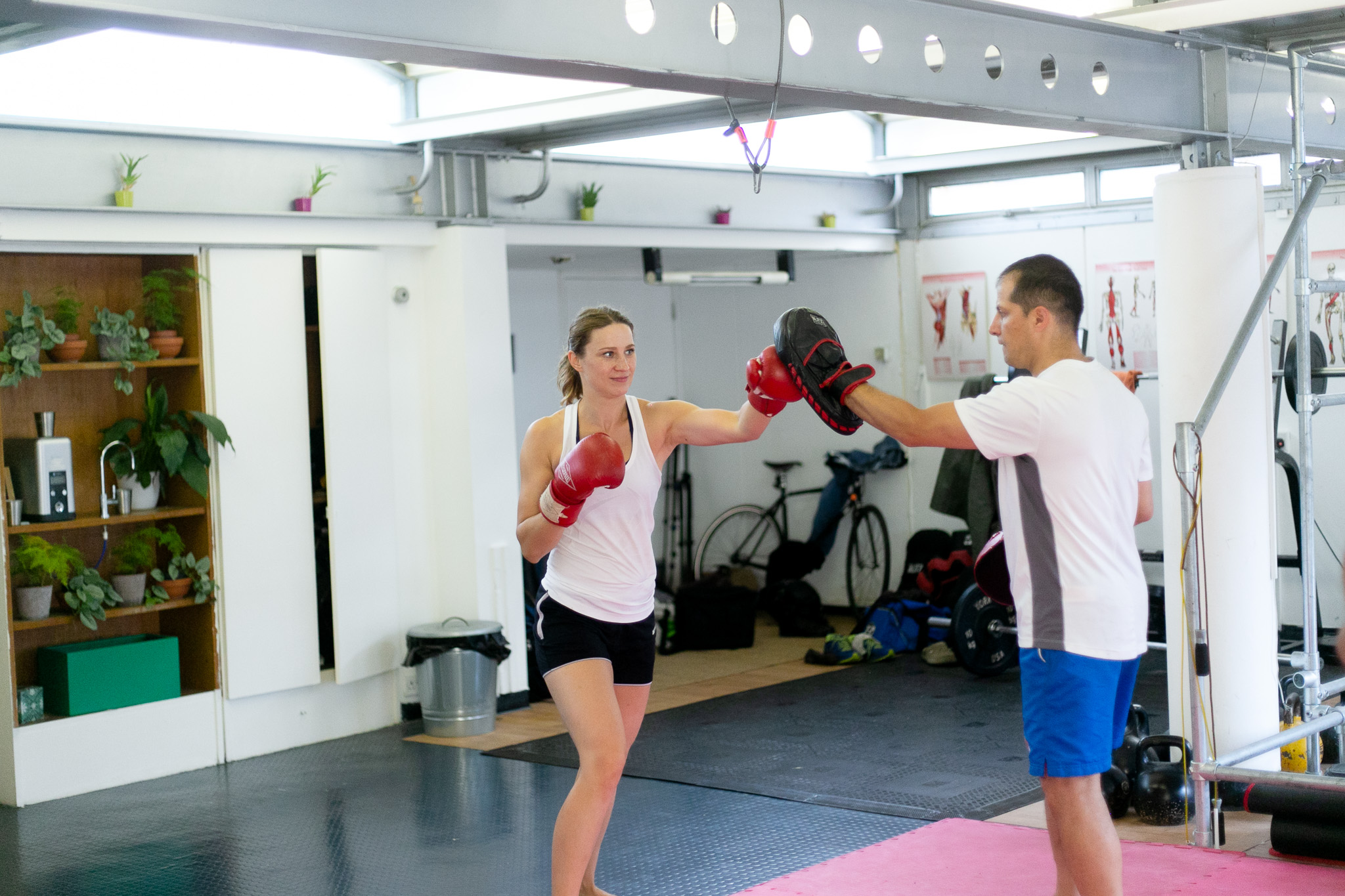Kickboxing based personal training is a really good approach for a lot of men and women. It’s a whole body workout, which includes, develops and challenges a lot of different fitness components. Kickboxing training develops whole body flexibility, whole body strength and power, coordination and body awareness. It also develops good timing and the reflexes.
An essential part of kickboxing training is stamina development. So you will work to build the strength and efficiency of the heart and longs as well as the muscular endurance of limbs and trunk. The combination of cardiovascular, high calorie burning workouts, and the muscular development training help to develop the type of physiques that many people admire.
Because it’s a real martial art and craft, the development process is essentially unlimited, meaning it’s a kind of training that you can really get into and study in detail if you want to. Some people just want to have a fun and effective workout, which is also valid.
The different style of kickboxing
There are many different styles and approaches to kickboxing. The term itself is a bit of a catch-all and first came into use in the 1970’s in America. It was essentially a full contact form of Karate, and then western boxing techniques started to be implemented. In the old days a lot of the early American kickboxing organisations (PKA etc) would allow low kicking and actually made you throw a certain amount of kicks per round as a minimum. It looks a little dated and limited now, when compared to more inclusive systems such as Muay Thai.
In Thailand Muay Thai had been practiced in various forms and under various names since the 1700’s. In the 1900’s the term Muay Thai began to be used and competitions started to be held in rings, similar to western boxing. The ruleset of Muay Thai allows more techniques than the early western style kickboxing, which generally prohibited the low kicks, knees and elbows which were perfectly legal in Muay Thai. Muay Thai is heavily influenced in Thailand by gambling syndicates and sometimes the tactics used and the pacing of the matches reflects that. Because of the knees and elbows, Muay Thai is quite a hardcore format to compete in, though the training is very direct, no-nonsense and concerned only with things that are practical. Limitations are in the stances and footwork, due to the ring emphasis on low kicks, so fighters adopt a less mobile and higher stance to check the low kicks. Leitwei is the Burmese counterpart to Muay Thai and looks very similar although matches are contested bare knuckle and so look even more brutal.
Dutch boxing/Dutch Kickboxing comes from the Netherlands and is an offshoot of Muay Thai, and in some cases includes some influence from Kyokoshynkai Karate (Vos Gym). It includes a more developed western boxing game, so fighters tend to be better at sitting down on their punches and leveraging more power. They also use the low kick even more than the Thais and work a lot of low high combinations and vice versa. Gyms in Amsterdam who teach this style tend to include a lot of full contact sparring in all the classes, which is very different to the Thai approach, who rarely spar full contact. Some people consider the Dutch boxing style of kickboxing the epitome of striking for full contact competition.
In China there was a history of challenge matches being fought on rope-less platforms since the Song dynasty (1200’s). Fighters and wrestler would contest their skills in bloody matches, for money or bragging rights. Modern competitions known as kuoshu or sanshou/san da have been fought in China and other asian countries since the early 1900’s. The ruleset of many Lei Tai competitions was quite ‘free’ allowing throws and full contact to all parts of the body. In modern Sanshou and San da competitions, rules are similar to Muay Thai, minus the elbows and knees, but with throws and takedowns encouraged by the scoring system. San Da kickboxing includes a highly developed system of striking (including boxing and spinning attacks) as well as a complete system of seamless throws, trips and sweep. I consider it to be the best approach if you want to get rock solid self defence skills, because of the grappling development and high level striking. The MMA phenom ‘Zabit’ was originally a San Da fighter (World champion) and his ability to mix all these different striking and grappling elements has made him an absolute monster in the UFC.
In this old illustration you can see the emphasis on throws in the old Chinese kickboxing approach (San Da)
The style you will learn
For my kickboxing students and clients I keep things firmly focussed on developing really good all purpose martial arts skills. So I build a good base of precision and power striking, using all kinds of kicks, punches, elbows and knees.
I help students develop excellent evasive skills, head movement exercises, use of parries and diversions as well as trapping and jamming techniques. We also work a lot on footwork skills for attacking and defensive techniques. Coordination and pattern recognition drills are an important part of the training, building natural skills and reflexive action.
We use a lot of pad work to build a lot of technical fluency and the ability to spontaneously select the correct strikes on the fly.
In my kickboxing system I train foot sweeping drills, clinch fighting, takedowns and throws. This all comes from a Sanshou/San Da approach to kickboxing and is useful for self defence too.
The types of strength, conditioning and fitness techniques I use for kickboxing PT
Practicing the pad drills and technical drills will go a long way to building a high level of fitness. On top of this I like to add key exercises to completely condition the practitioner. These approaches included some weighted exercises for power, some calisthenic exercises for whole body muscle endurance and conditioning. There are some unique stamina building exercises we focus on, that build high intensity fitness, as well as a wide range of stretching and flexibility drills.
Why kickboxing focussed personal training might be the right approach for you
A personal training approach that is focussed on Kickboxing is a really good option for some people. Here are some reasons why it might be suitable for you;
- It’s easy to burn a lot of calories during a high intensity pad work session – helping you to become leaner or lose excess weight
- You can easily add tone your physique and add muscle mass and strength in an aesthetically balanced way from the calisthenic workouts
- You will become looser and more flexible.
- Kickboxing sessions build a lot of aerobic (and anaerobic) fitness
- You will become more coordinated and athletic
- Workouts are very varied, and skill based so its a pretty fun way to train
- You can just do it as a workout or you can approach it in a ‘learning’ style
- You can gain some handy self defence skills and boost conifdence
Am I too old or unfit to do Kickboxing style workouts?
Almost anyone can do kickboxing style sessions. If you are not in great shape yet, or feel you are on the older side of things, don’t worry. All training methods can be modified in terms of intensity and challenge, so that it will match your current level. All that matters is starting. You will always improve and develop as long as you keep practicing regularly, and most people surprise themselves at how much progress they can make as long as they turn up and train regularly.
What do I need to wear for the workouts?
Training can be done in regular gym clothes and you don’t need any special equipment to get started. We have gloves here but they are used by other clients and students so I do recommend people invest in their own set of boxing or MMA gloves. These can be found quite cheaply online and I can give recommendations. To start with though you don’t need anything other than yourself and some loose training clothes.
Where do you give your personal training?
I train most people at the Camden Studio, which is opposite Camden Town tube station. Some clients get me over to their home or a local park. As long as its within a reasonable travelling distance I’m happy to find a mutually convenient location and bring my equipment with me.
How much do personal training sessions with you cost?
I keep session prices well priced, though these vary depending on where and when you train and how often you train. Just get in touch to discuss what you’d like to do and I can give you can accurate quotation.
What does a typical kickboxing PT session involve?
Each session tends to be quite unique, but to ensure progression and proper development we tend to keep some elements pretty regular.
The warm up
Typically this would last about 10 to 15 minutes and would begin with a few exercises that increase your bodies’ core temperature as well as mobilises the major joints and connective tissues patterns. We then move onto slightly more sport specific loosening exercises which also serve to groove your body into certain beneficial and relevant movement patterns for kickboxing. Dynamic flexibility work on the floor and in an upright position is normally next, loosening in particular the lower body and getting it ready for the work to come.
Next comes the strength and power part of the session, using various calisthenic drills and weighted exercises to build the general strength and power and also specific strength and power of the right muscles and movement patterns for kickboxing.
Normally the next activity is pad work and bag work. Grooving the right lines for all the major striking techniques using all your limbs, as well as introducing and drilling a lot of defensive techniques and footwork patterns.
Once the pad work has been done we will tend to work on partner drills, where you will practice all the defensive and offensive techniques of the syllabus, with me feeding you techniques to work with and so on. It’s cooperative drilling, but there are many spontaneous elements to help you develop real skills.
From there we will tend to work on some type of movement drill that will cool you down and then complete the session with developmental stretches designed to increase your flexibility.
Kickboxing sessions are 60mins long but you will feel fully exercised, energised and engaged on all levels.
How do I get started?
All you need to do is either give me a call or drop me a message using the form below. Please include a little information about yourself and how you would like to train etc.[/vc_column_text][/vc_column][/vc_row][vc_row][vc_column]




